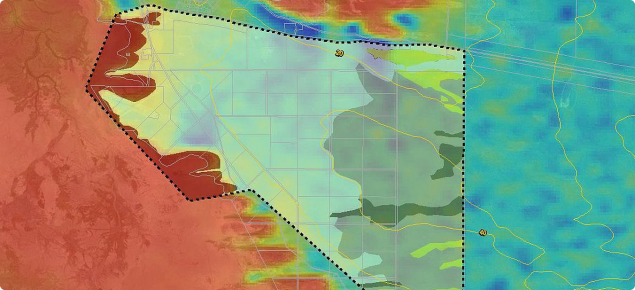Our role in the Knowsley Agricultural Area project
We and our partner GHD conducted a land capability assessment and agronomic study of dryland options as part of the investigations for this project. The information on this page is from the joint report to the (then) Department of Water.
Land capability for dryland agriculture refers to the ability of the land to support stock grazing and cropping that is applied at current best practice without causing degradation to the soil, land, air and water resources.
The project was funded by the Western Australian Government through the Royalties for Regions initiative.
What we did
The partners did a desktop land capability assessment for dryland pasture and annual crops for part of the Knowsley Agriculture Area (KAA):
- reviewed existing soils, vegetation and terrain data and information
- mapped 7 land units
- assessed the land units on their capability for dryland perennial pasture production and for fodder cropping and grain production.
What we found
-
Average rainfall deficits in a wet season are ~16 days with an average of ~6 deficit periods: dry periods of these durations and frequencies during the wet season would be a major limitation to dryland agriculture.
- Approximately 85% of the area (6040ha) had a high to fair capability for dryland perennial pasture production and a fair to low capability for fodder and grain cropping.
-
Improved perennial pasture systems are most suited (of the options assessed) to this low rainfall environment. There is a risk of wind and water erosion during establishment.
-
Partially irrigated pasture systems (leucaena and buffel grass) have a high chance of success due to the reduced risk of rainfall deficits. The cost of irrigation infrastructure is high, and leucaena and buffel grass are potential environmental weeds.
-
Fodder production with non-irrigated annual crops has good potential. Annual cropping does damage soil structure and renders topsoil vulnerable to wind and water erosion as well as a loss of soil structure.
-
Grain production has poor potential, because of low and infrequent rainfall. This production system also requires high management of pests, nutrition and weeds, has limited established markets for the grain.
-
Tree crops are not likely to be suited to this site. Gubinge trees are native to this area, but it is very site specific and more suited to coastal areas. Establishment away from the coast is patchy and yield per hectare can be poor. Management of this species is not well understood, and there is no established market for the harvested product.
-
Economic analysis of the options, showed that fodder production, closely followed by improved perennial psture, had the highest net present value (Table 1).
| Item | Improved perennial pastures | Fodder production | Grain production | Partially irrigated systems |
|---|---|---|---|---|
| Earnings before interest & tax | $172 602 | $198 664 | $135 249 | $438 115 |
| Total Establishment Costs | $814 000 | $870 500 | $877 000 | $4 939 000 |
| NPV of returns over 12 years | $283 600 | $315 897 | -$124 132 | -$1 941 787 |
For more information
Download the Knowsley Agricultural Area Land Capability Assessment and Agronomic Study report.

